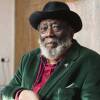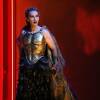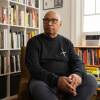Astronomer Maria Mitchell said of the night sky, “Do not look at stars as bright spots only. Try to take in the vastness of the universe.” In Springfield, a collaboration between a planetarium and a dance company is doing just that.
To mark its 85th anniversary, the Springfield Museums Seymour Planetarium has partnered with Luminarium Dance Company to create Constellation Stories. The project, which takes place at the planetarium on November 5th, will use dance to interpret astronomy-based mythologies from around the globe, reflecting the diversity and various cultures — in other words, the vastness — of Springfield along the way.
Springfield is home to more than 54,000 Puerto Ricans, and is almost 46% Hispanic or Latino . Luminarium Artistic Director Merli V. Guerra hopes the project will “tie into the history of the planetarium itself and also tie into the history of the actual demographics of the current greater Springfield area.”
“As a museum, we want to be more inclusive of cultures from all over the world, because we know that our city, the city of Springfield, is just such a wide variety of different people,” said Springfield Museums Director of Science Jenny Powers. “We want them to feel that they are being celebrated at the Springfield Museums.”
This collaboration is part of an ongoing series by Luminarium Dance Company's Guerra titled PLACE, which stands for "Presenting Landmarks through Artistic Community Engagement."
This year, that landmark is the Seymour Planetarium.
Watch Merli V. Guerra discuss how she uses dance to connect to the past
Opening amid the Great Depression, the planetarium's staff couldn't afford to purchase a star projector, so they literally and figuratively reached for the stars. A team led by Frank Korkosz, a technician who worked at the Springfield Science Museum, created the Korkosz Projector, which is now the oldest operating American-made projector in the world. This invention, also known as the “starball,” required Dr. Korkosz to punch over 7,000 tiny holes into 4-inch tin circles covering a 500-watt bulb to create a spray of thousands of "stars."
“The fact that someone just decided, since we can't afford this, we're just going to make it — we're still celebrating that 85 years later because that's just such an optimistic and relevant way of thinking,” said Powers. “[Korkosz] has educated many hundreds of thousands, if not millions of people with this starball.”
Now, the planetarium uses the stars to illuminate Springfield’s cultural diversity. One culture featured in particular is that of the Taíno people, who originally inhabited the Caribbean including Puerto Rico, the Dominican Republic, Haiti, Cuba, Jamaica and the Virgin Islands.

Chali’Naru Dones is a Borikén Taíno woman and member of the Guainía Taíno Tribe. She is also the liaison to the United Confederation of Taíno People (UCTP), an “indigenous representative institution established in 1998 to promote the self-determination and protection of the human rights, culture, traditions, and sacred lands of Taíno and other Caribbean Indigenous Peoples.”
She and her son Tata’niki, who is 11 years old, will perform a series of Taíno Solos including an Owl dance, done to evoke the night sky, as well as a reworked Makana dance , a traditional Taíno war dance, that aims to reflect Taíno mythology before closing with a gratitude chant.
"Bringing Taíno dance is very important to me because not only does it demonstrate the richness of our culture but also lets people know that thousands of years before colonization we have our own ways, our own beliefs, our own connections to Bibi Atabei (mother Earth), to Baba Turei (father sky) and to Arakoel Guei (Grandfather Sun)," said Dones.
The collaborative project will use dance, light and science to also tell stories from China, Japan, Estonia, Greece and Cape Verde.
“My goal is that when people look up at the sky after this, they might look at the Milky Way and think of their own stories or their own cultural backgrounds and how it might influence the way they look at the night sky,” said Guerra.

The event is free with museum admission and open to all ages. The event also includes hands-on astronomy, observatory tours, and presentations by planetarium educators and members of the Springfield STARS Club. Lumin








